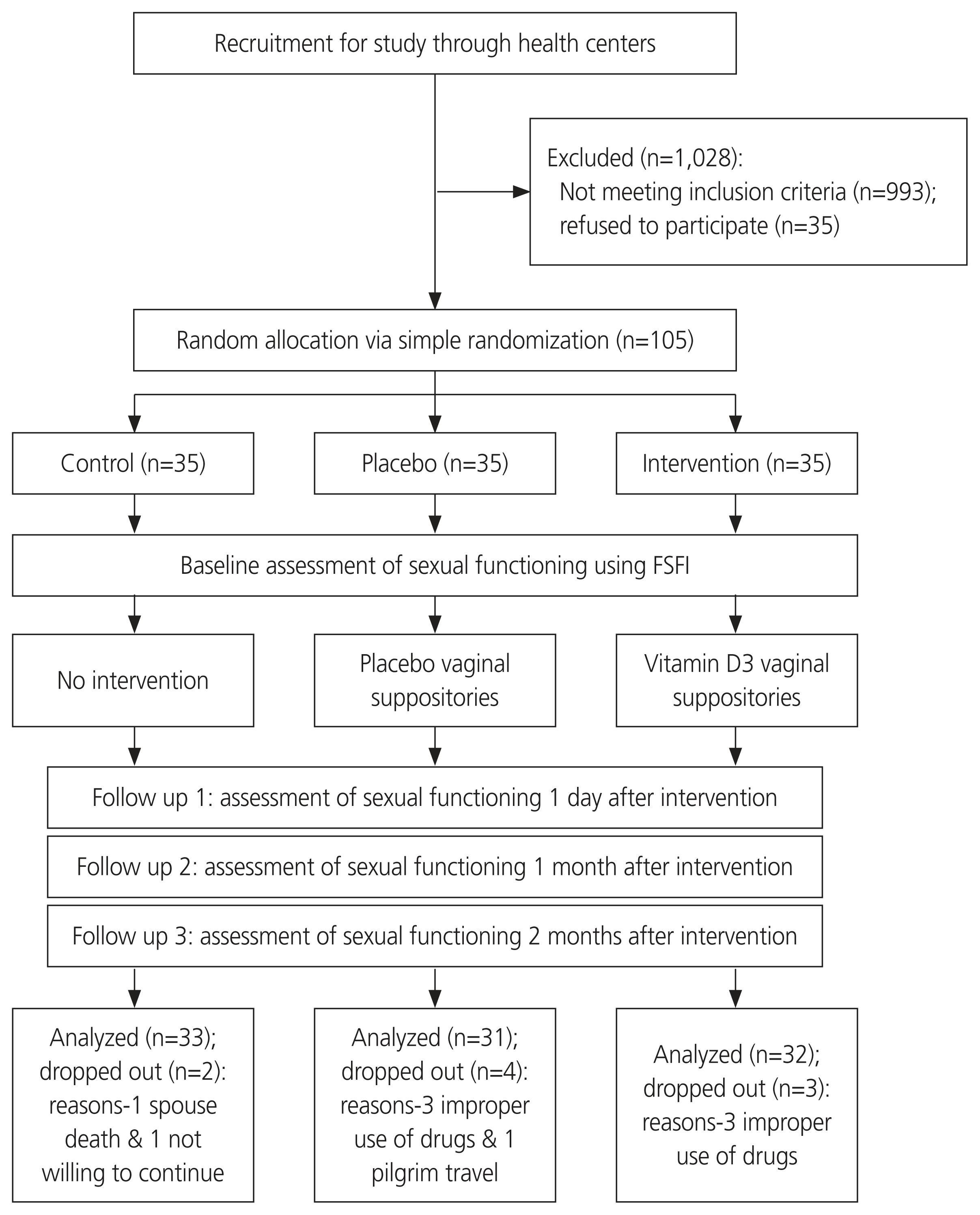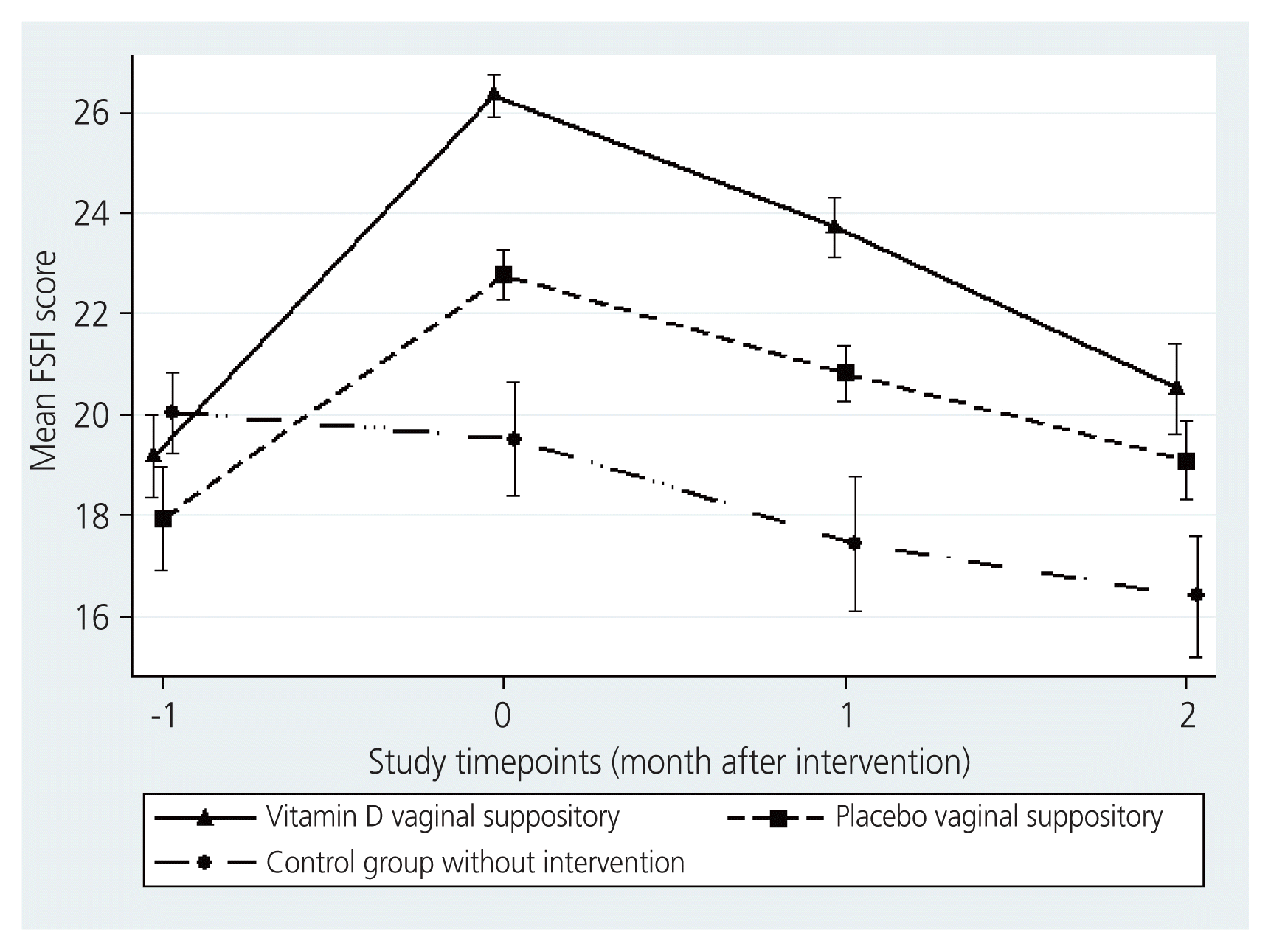1. Sturdee DW, Panay N. Recommendations for the management of postmenopausal vaginal atrophy. Climacteric. 2010; 13:509–22.

2. Mac Bride MB, Rhodes DJ, Shuster LT. Vulvovaginal atrophy. Mayo Clin Proc. 2010; 85:87–94.

3. Casarotti GA, Chiodera P, Tremolada C. Menopause: new frontiers in the treatment of urogenital atrophy. Eur Rev Med Pharmacol Sci. 2018; 22:567–74.
4. Cumming GP, Herald J, Moncur R, Currie H, Lee AJ. Women’s attitudes to hormone replacement therapy, alternative therapy and sexual health: a web-based survey. Menopause Int. 2007; 13:79–83.

5. Kiraly SJ, Kiraly MA, Hawe RD, Makhani N. Vitamin D as a neuroactive substance: review. ScientificWorldJournal. 2006; 6:125–39.

6. Kinuta K, Tanaka H, Moriwake T, Aya K, Kato S, Seino Y. Vitamin D is an important factor in estrogen biosynthesis of both female and male gonads. Endocrinology. 2000; 141:1317–24.

7. Costantino D, Guaraldi C. Effectiveness and safety of vaginal suppositories for the treatment of the vaginal atrophy in postmenopausal women: an open, non-controlled clinical trial. Eur Rev Med Pharmacol Sci. 2008; 12:411–6.
8. White JH. Profiling 1,25-dihydroxyvitamin D3-regulated gene expression by microarray analysis. J Steroid Biochem Mol Biol. 2004; 89–90:239–44.

9. Abban G, Yildirim NB, Jetten AM. Regulation of the vitamin D receptor and cornifin beta expression in vaginal epithelium of the rats through vitamin D3. Eur J Histochem. 2008; 52:107–14.

10. Kim GM, Jeon GH. Serum vitamin D levels and ovarian reserve markers in secondary amenorrhea patients: is there a link? Obstet Gynecol Sci. 2020; 63:521–8.

11. Abdi F, Amjadi MA, Zaheri F, Rahnemaei FA. Role of vitamin D and calcium in the relief of primary dysmenorrhea: a systematic review. Obstet Gynecol Sci. 2021; 64:13–26.

12. Rahnemaei FA, Gholamrezaei A, Afrakhteh M, Zayeri F, Vafa MR, Rashidi A, et al. Vitamin D supplementation for primary dysmenorrhea: a double-blind, randomized, placebo-controlled trial. Obstet Gynecol Sci. 2021; 64:353–63.

13. Schulte-Uebbing C, Schlett S, Craiut D, Bumbu G. Stage I and II stress incontinence (SIC): high dosed vitamin D may improve effects of local estriol. Dermatoendocrinol. 2016; 8:e1079359.

14. Lotfi B, Esmaeil Nasab N, Aghaei A, Ahmadi Jouybari T. Evaluation of breast cancer in Iranian women in an ecological study based on latitude, sun exposure and vitamin D intake. Iran J Obstet Gynecol Infertil. 2014; 17:17–25.
15. Monastra G, De Grazia S, De Luca L, Vittorio S, Unfer V. Vitamin D: a steroid hormone with progesterone-like activity. Eur Rev Med Pharmacol Sci. 2018; 22:2502–12.
16. de Villiers TJ, Pines A, Panay N, Gambacciani M, Archer DF, Baber RJ, et al. Updated 2013 International Menopause Society recommendations on menopausal hormone therapy and preventive strategies for midlife health. Climacteric. 2013; 16:316–37.

17. Johansen C, Kragballe K, Henningsen J, Westergaard M, Kristiansen K, Iversen L. 1alpha,25-dihydroxyvitamin D3 stimulates activator protein 1 DNA-binding activity by a phosphatidylinositol 3-kinase/Ras/MEK/extracellular signal regulated kinase 1/2 and c-Jun N-terminal kinase 1-dependent increase in c-Fos, Fra1, and c-Jun expression in human keratinocytes. J Invest Dermatol. 2003; 120:561–70.
18. Jetten AM, Nervi C, Vollberg TM. Control of squamous differentiation in tracheobronchial and epidermal epithelial cells: role of retinoids. J Natl Cancer Inst Monogr. 1992; (13):93–100.
19. Eckert RL, Efimova T, Dashti SR, Balasubramanian S, Deucher A, Crish JF, et al. Keratinocyte survival, differentiation, and death: many roads lead to mitogen-activated protein kinase. J Investig Dermatol Symp Proc. 2002; 7:36–40.

20. Yildirim B, Kaleli B, Düzcan E, Topuz O. The effects of postmenopausal vitamin D treatment on vaginal atrophy. Maturitas. 2004; 49:334–7.

21. Rad P, Tadayon M, Abbaspour M, Latifi SM, Rashidi I, Delaviz H. The effect of vitamin D on vaginal atrophy in postmenopausal women. Iran J Nurs Midwifery Res. 2015; 20:211–5.
22. Daan NM, Fauser BC. Menopause prediction and potential implications. Maturitas. 2015; 82:257–65.

23. Sarebani Z, Alimoradi Z, Aali E, Mirzadeh M, Chegini V, Abbaspour M, et al. Investigating the effect of vitamin D vaginal suppository on sexual function among postmenopausal women: study protocol for a randomized controlled trial. BMC Womens Health. 2020; 20:27.

24. Cayan F, Dilek U, Pata O, Dilek S. Comparison of the effects of hormone therapy regimens, oral and vaginal estradiol, estradiol + drospirenone and tibolone, on sexual function in healthy postmenopausal women. J Sex Med. 2008; 5:132–8.
25. Rosen R, Brown C, Heiman J, Leiblum S, Meston C, Shabsigh R, et al. The female sexual function index (FSFI): a multidimensional self-report instrument for the assessment of female sexual function. J Sex Marital Ther. 2000; 26:191–208.

26. Fakhri A, Pakpour AH, Burri A, Morshedi H, Zeidi IM. The female sexual function index: translation and validation of an Iranian version. J Sex Med. 2012; 9:514–23.

27. Alshahrani F, Aljohani N. Vitamin D: deficiency, sufficiency and toxicity. Nutrients. 2013; 5:3605–16.

28. Vieth R. Vitamin D supplementation, 25-hydroxyvitamin D concentrations, and safety. Am J Clin Nutr. 1999; 69:842–56.

29. Kimball S, Vieth R. Self-prescribed high-dose vitamin D3: effects on biochemical parameters in two men. Ann Clin Biochem. 2008; 45:106–10.

30. Taylor PN, Davies JS. A review of the growing risk of vitamin D toxicity from inappropriate practice. Br J Clin Pharmacol. 2018; 84:1121–7.

31. Imbens GW, Rubin DB. Causal inference in statistics, social, and biomedical sciences. 1st ed. Cambridge: Cambridge University Press;2015.
32. Fritz CO, Morris PE, Richler JJ. Effect size estimates: current use, calculations, and interpretation. J Exp Psychol Gen. 2012; 141:2–18.

33. Copay AG, Subach BR, Glassman SD, Polly DW Jr, Schuler TC. Understanding the minimum clinically important difference: a review of concepts and methods. Spine J. 2007; 7:541–6.

34. Krychman M, Rowan CG, Allan BB, Durbin S, Yacoubian A, Wilkerson D. Effect of single-session, cryogen-cooled monopolar radiofrequency therapy on sexual function in women with vaginal laxity: the VIVEVE I trial. J Womens Health (Larchmt). 2018; 27:297–304.

35. Sedaghat AR. Understanding the minimal clinically important difference (MCID) of patient-reported outcome measures. Otolaryngol Head Neck Surg. 2019; 161:551–60.

36. Jacobson NS, Truax P. Clinical significance: a statistical approach to defining meaningful change in psychotherapy research. J Consult Clin Psychol. 1991; 59:12–9.

37. Weber MA, Limpens J, Roovers JP. Assessment of vaginal atrophy: a review. Int Urogynecol J. 2015; 26:15–28.

38. Pearson T. Atrophic vaginitis. J Nurse Pract. 2011; 7:502–12.

39. Zeyneloglu HB, Oktem M, Haberal NA, Esinler I, Kuscu E. The effect of raloxifene in association with vitamin D on vaginal maturation index and urogenital symptoms in postmenopausal osteoporotic women. Fertil Steril. 2007; 88:530–2.






 PDF
PDF Citation
Citation Print
Print




 XML Download
XML Download